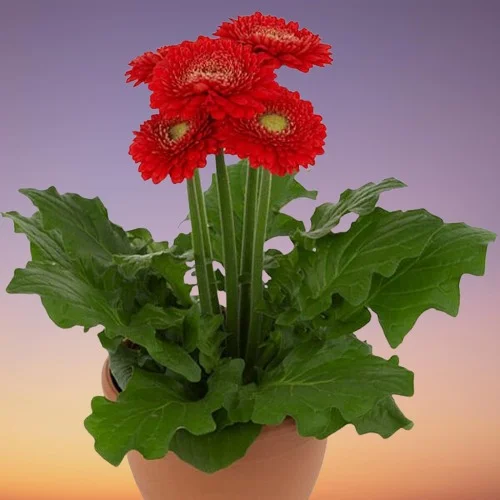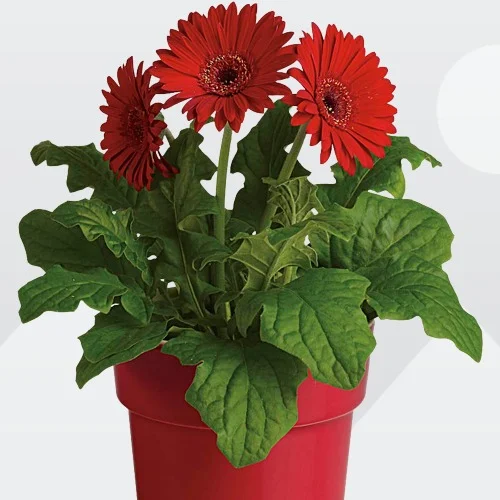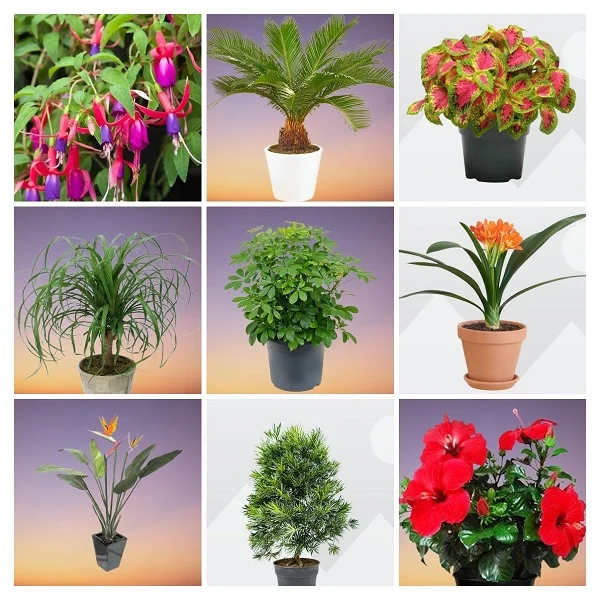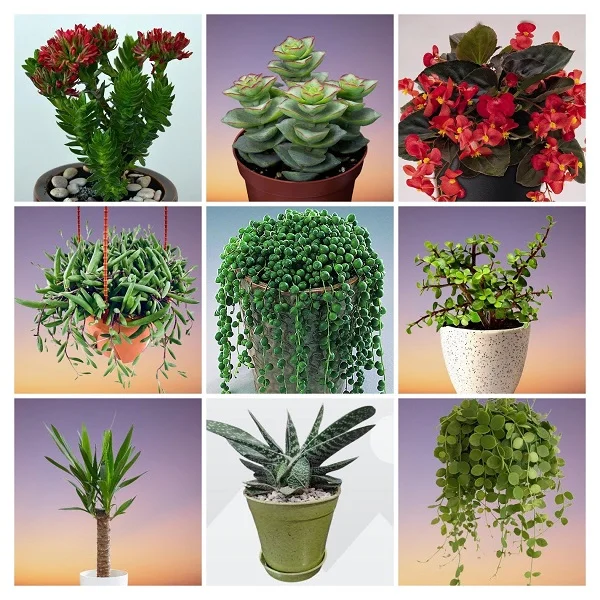Gerbera jamesonii (Gerbera Daisy) Indoor Care and Propagation Guide
Some links in this post may be affiliate links
Gerbera Daisy (Gerbera jamesonii) grows best in bright light with 6-8 hours of sunlight, average warmth and humidity, and moderately moist, rich, well-drained soil with monthly feeding in spring and summer.
Before diving into care tips, let’s get to know this gorgeous plant a little better. Gerbera jamesonii also called Barbeton Daisy or Transvaal Daisy is among the popular flowering plants for a well-lit spot. The striking flowers are a pleasant sight to behold in any space.
There are many colorful Gerbera Daisy plants available. The flower colors range from soft pink, white, pale yellow, pink, orange, red and purple. The hybrids are more compact and produce up to six blooms at a time.
To get more blooms, once a flower fades, cut off the flower stalk at the base to encourage more blooming.

Botanical name: Gerbera jamesonii
Family: Asteraceae
Common names: Gerbera Daisy, Barbeton Daisy, Transvaal Daisy
Origin
Gerbera Daisy is native to South Eastern Africa. It was first described by Robert Jameson in 1889 while exploring the Barberton area of South Africa.
Gerbera jamesonii belongs to the Asteraceae (Daisy) family formerly Compositae together with Purple Coneflower (Echinacea purpurea), Sunflower, Dahlias and Black-eyed Susan.
Size
Transvaal Daisy has been grown as a flowering pot plant for a long time and it grows to a height of 2 feet. The leaves are about 6 in. long, deeply veined and soft and hairy on the undersides.
Air Purifying
According to the NASA Clean Air Study, Gerbera jamesonii was found to be among the best air-cleaning plants. It gets rid of formaldehyde and benzene from indoor air.
Is Gerbera jamesonii poisonous?
No. Gerbera Daisies are non-toxic to both humans and pets as indicated by ASPCA. They are safe for cats, dogs and other pets.
Where to Buy
Gerbera jamesonii are pretty plants to add to your plant collection. If you are looking to grow these plants, you may obtain the seeds and live plants online from Amazon (Link to Amazon).
How to Care for Gerbera jamesonii indoors
To care for Gerbera jamesonii indoors, provide bright light with 6-8 hours of direct sunlight, warmth of 15-250C, humidity of 50-55% and moderately moist, rich, well-drained soil coupled with monthly feeding during the growing season.
Gerbera Daisy care does not require too frequent repotting as it blooms best when pot-bound, repot only when extremely pot-bound. Regular pruning is needed to keep it neat and to encourage flowering. Keeping Gerbera Daisy healthy indoors requires proper light, watering, and maintenance. Let’s break it down step by step.

Watering
How often should you water Gerbera Daisy?
Water your Gerbera Daisy liberally in spring and summer only when the top 2-3 inches of soil dry out. Keep the soil moderately moist and avoid overwatering to prevent rotting, yellowing and leaf loss.
Cut down on watering in fall and winter to maintain the soil slightly moist as growth is minimal at this time. Do not allow the soil to dry out completely to prevent wilting, drooping, yellowing and leaf fall.
Use water that is at room temperature to prevent cold shock which can result in stunted growth and leaf drop. Ensure the water is free of chlorine and other chemicals to prevent browning of leaf edges.
Ascertain that the pot has a drainage hole and the soil is well-draining to prevent waterlogging which can lead to root-rot and eventual death of the plant.
Avoid wetting the crown to minimize fungal infestations like leaf spot disease, powdery mildew, and crown and stem rot disease.
Light Requirements
Do Gerbera Daisies like full sun or shade?
Gerbera Daisies flourish in bright light with 6-8 hours of morning or late afternoon sunlight. Keep them away from hot midday sunshine to avoid scorching of the leaves.
Too little light will cause reduced growth, yellowing, leaf drop and lack of blooms. Where the natural light is not sufficient, use a full spectrum grow light to supplement it.
Regularly turn the pot to ensure the Barbeton Daisy gets adequate light on all sides to prevent lopsided growth.
Temperature & Humidity
Transvaal Daisy prefers a warmth of 15-250C. Keep it away from sources of drafts like AC units, hot air vents, windy doors, drafty windows and others to prevent stunted growth, leaf drop and reduced flowering.
Gerbera Daisy has no need for extra humidity; a humidity of 50-55% is adequate for this plant. However, where the air is too dry, set the pot on a wet pebble tray or use a cool mist humidifier to increase humidity. Ensure that there is good air circulation to prevent fungal diseases.
Fertilizer
Feed your Gerbera Daisy every 3-4 weeks in spring and summer with a water-soluble fertilizer that contains micro-nutrients like Iron, Zinc and Magnesium which are needed for the healthy growth of the plant.
Withhold feeding in fall and winter as growth is minimal at this time and feeding at this time can result in fertilizer burn and death of the plant.
Occasionally, flush out accumulated chemicals (salts) from the soil by running a stream of water through the soil until it drains through the drainage hole. Allow the stream of water to run for some time and repeat the process several times.
Potting Soil
The best potting soil for Gerbera Daisy should be light, well-draining with good aeration, rich in organic matter to provide the required nutrients and at a PH between 5.5 and 6.5. If the PH is too low the leaves develop black spots and patches. Where the PH is too high the leaves develop yellow stripes.
Very well-drained soil is important to prevent the plant from getting soggy as it can lead to root-rot and death of the plant. A blend of 3 parts of multipurpose potting mix amended with 1 part perlite (for drainage) is perfect for this plant.
Repotting
Repot Barbeton Daisy only when extremely pot-bound as it blooms more when slightly pot-bound. Do not repot a plant that is in flower as it can shorten the flowering period.
Use a pot 1 size larger that has a drainage hole to prevent waterlogging which can lead to root-rot. Check out these self watering planters with drainage hole on Amazon.
Pruning & Grooming
Pruning Gerbera Daisy is easy. Remove dead leaves and stems to keep the plant neat and discourage pests and diseases.
To encourage more blooms, cut off the flower stem at the base once flowering is over.
Regularly clean the leaves by damp-wiping with a soft cloth to get rid of dust and discourage pest infestations.
Gerbera jamesonii Propagation
Gerbera jamesonii is best propagated by plant division at the beginning of the growing season (spring to early summer) when in active growth.
Propagating Gerbera Daisy by plant division
- Water the plant thoroughly at least 1 day before to make it easier to divide and also hasten establishment; a well hydrated plant suffers less shock and takes a shorter time to take root.
- Slip the plant out of its pot and get rid of excess soil from the roots with your hands or wash it off with some water.
- Carefully divide the plant into sections while ensuring each section has some roots to hasten establishment.
- Select a 6 or 8 inches pot and make sure that the pot has adequate drainage to prevent the soil from getting soggy as it can lead to rotting.
- Fill the pot with a quality potting mix and make a hole in the center of the pot. Ensure that the hole is slightly wider than the root base of the section.
- Place the section in the previously made hole and lightly firm the soil around the base while taking care not to bury it too deep; maintain the section at the same soil level it was in the previous pot.
- Confirm that the crown of leaves is above the soil surface to prevent rotting.
- Thoroughly wet the soil until water comes out through the drainage holes.
- Place the pots in a warm (21-270C), brightly-lit place away from direct sunlight to avoid scorching.
- Maintain the soil moist until the new plant is well established after which you can begin routine.
How to Grow Gerbera Daisy from seeds
- Spread the seeds evenly on moist free-draining soil and cover lightly withsome soil.
- Cover the set up with a plastic sheet to create a greenhouse effect to encourage germination.
- Place the set up in a warm (21-270C), well-lit place away from direct sunlight.
- Maintain the soil moist through out by gently misting the soil surface until germination takes place.
- Once the seeds have germinated and there is substancial growth, begin hardening the seedlings to get them accustomed to growing in room conditions. Gradually over a period of 2 weeks, remove the polythene sheet a little bit per day.
- After hardening, transplant the new plants into individual pots in free-draining soil and begin routine care.

Gerbera jamesonii Problems & Remedies
Gerbera Daisy problems are plant dying, lack of blooms, wilting, yellow leaves, leaf spots, mold, rotting, pests and diseases among others.
Plant dying
Gerbera Daisy may be dying due to too little light, poor quality soil, poor feeding, root-rot, pest infestations, cold drafts, low humidity, incorrect watering among others.
Read more on 10 Reasons Why Gerbera Daisy is Dying and How to Revive It
Lack of blooms
Gerbera Daisy may fail to bloom due to too little light, incorrect watering, poor feeding, wrong temperatures, low humidity, lack of pruning, poor soil quality, pests infestations among other reasons.
Check out these 11 Reasons Why Gerbera Daisy is Not Blooming and How to Promote Flowering.
Pests
Common pests on Gerbera Daisy are aphids, scale insects, spidermites, fungus gnats and caterpillars.
Isolate the affected plant to prevent spread to the other plants and treat it with insecticidal soap or neem oil as per the manufacturers' instructions.
Diseases
Gerbera Daisy is prone to root-rot, crown-rot disease, leaf spot disease, botrytis disease, powdery mildew and viral diseases.
Read more on Gerbera Daisy (Gerbera jamesonii) Common Problems and their Solutions.
Final thoughts
Growing Gerbera daisies indoors takes a little extra effort, but the reward is endless colorful blooms. With the right light, watering, and fertilization, your Gerbera daisy will thrive and bloom beautifully all year long!
Frequently Asked Questions
1. How do you keep Gerbera Daisies alive indoors?
To keep Gerbera Daisies alive indoors give them bright light with 6-8 hours of direct sunlight, warmth of 15-250C, humidity of 50-55% and moderately moist, rich, well-drained soil coupled with regular feeding in spring and summer.
2. How often do you water Gerbera Daisy indoors?
Water Gerbera Daisy liberally during the growing season while allowing the top 2-3 inches of soil dry out between waterings. Decrease watering in the cold season but do not allow the soil to dry out completely.
3. Do Gerbera Daisies need direct sunlight?
Yes. Gerbera Daisies require bright light with 6-8 hours of morning or late afternoon sunlight. However, protect them away from hot midday sunshine to avoid scorching the leaves.
4. Do Gerbera Daisies purify air?
According to the NASA Clean Air Study, Gerbera Daisies purify the air by getting rid of formaldehyde and benzene from the air.
5. Do Gerbera Daisy multiply?
Yes. Gerbera Daisy can be multiplied at the beginning of the growing season by plant division. Divide the plant into sections and plant these sections in individual pots.
6. Why is my indoor Gerbera Daisy not flowering?
Your indoor Gerbera Daisy may fail to flower due to too little light, incorrect watering, poor feeding, wrong temperatures, low humidity, lack of pruning, poor soil quality, pests infestations among others.
7. Why are my Gerbera Daisies dying?
Your Gerbera Daisies may be dying from root-rot, poor lighting, overwatering, underfeeding, cold drafts, pests infestations, being extremely pot-bound, wrong humidity among other reasons.
8. What is the best fertiizer for my Gerbera Daisies?
The best fertilizer for your Gerbera Daisies is a water-soluble fertilizer that contains micro-nutrients like Iron, Zinc and Magnesium applied every 3-4 weeks during the growing season.
9. Should I cut the dead flowers off my Gerbera Daisies?
Yes. Once flowering is over, cut off the flower stem at the base to encourage more blooming.
You liked it? Share on social media.
Related Content
Amazon Associates Disclosure
Homeplantsguide.com is a participant in the Amazon Services LLC Associates Program, an affiliate advertising program designed to provide a means for sites to earn advertising fees by advertising and linking to amazon.com.





